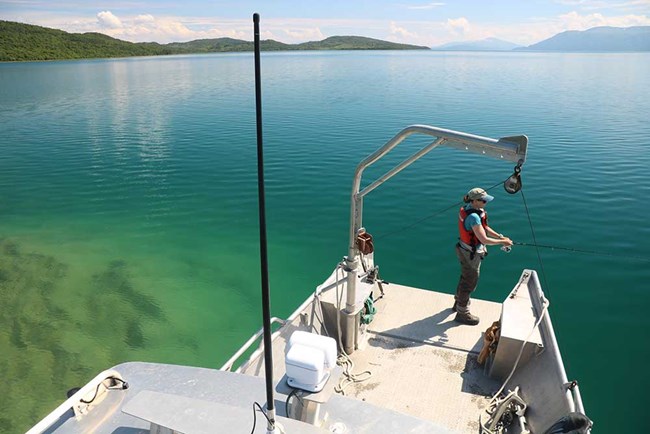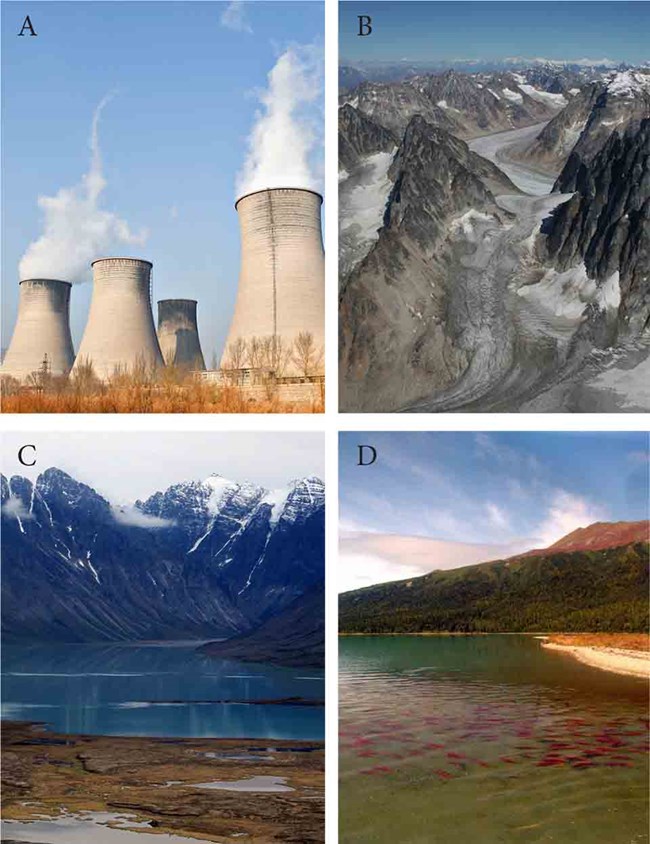Last updated: April 13, 2020
Article
Freshwater Contaminants in Southwest Alaska Parks

The sampling in Katmai (pictured above) was stymied because it coincided with a heat wave, which elevated surface water temperatures above 20°C in in focal lakes, well above the optimum thermal range for lake trout feeding. NPS/Paul Gabriel
Mercury is a toxic element with no known essential biological function. It occurs naturally as a solid in various minerals and as a gas in volcanic eruptions. It is also released into the environment as a gas by human activities, particularly mining and coal burning. Gaseous elemental mercury can be transported atmospherically to areas far from original sources, after which it can be oxidized and deposited on the earth’s surface in the form of rain or snow. Under anaerobic conditions, typically in wetland sediments, bacteria can convert this deposited inorganic mercury to organic methylmercury. Methylmercury may then accrue in aquatic organisms through the intake of water and food. In fish, methylmercury both bioaccumulates and biomagnifies, meaning it increases over time within an individual and it increases up the food chain across individuals. For this reason, long-lived top-predator species, like lake trout, have a high risk of mercury contamination, and diet is a key pathway by which contamination occurs.
Findings
In 2016, the National Park Service and the US Geological Survey initiated a study of the factors controlling lake trout mercury levels at thirteen lakes in Katmai and Lake Clark national parks and preserves. Results indicate that lake trout exhibit a wide range of mercury concentrations within and among lakes (Figure 1), with many concentrations exceeding the state guidance on unlimited consumption of Alaska-caught fish by at-risk groups (200 ng/g wet weight or 16 meals/month; Hamade 2014). Factors that best explain these concentrations are fish age, body condition, and diet specialization. Specifically, mercury tends to be higher in older, skinnier lake trout that feed offshore. Feeding location was inferred from carbon stable isotopes (δ13C values), with lower values indicating greater reliance on offshore (vs. nearshore) feeding.

The gray line represents the upper limit for unlimited human consumption of Alaska-caught fish, specifically for women of childbearing age, nursing mothers, and children under the age of 12.

Methods
The findings described above were derived from statistical models with limited explanatory power, due to the small sample size of thirteen lakes. These lakes were selected to represent a range of local factors capable of influencing the distribution of distantly derived mercury (Nagorski et al. 2014; Figure 2). Now we are adding data from three more lakes to the models to bolster the sample size. We also plan to launch a related project in 2021 that includes five parks in Alaska. Like the 2016 study, this project will use lake trout as a focal species, but it will also include associated prey species and primary producers, with the goal of assessing mercury bioaccumulation through the food web and determining whether specific foraging strategies (e.g., offshore vs. nearshore feeding) promote greater mercury buildup.
References
Hamade, A.K. 2014. Fish consumption advice for Alaskans: A risk management strategy to optimize the public’s health. State of Alaska, Section of Epidemiology. Anchorage, Alaska.Nagorski, S. A., and others. 2014. Spatial distribution of mercury in southeastern Alaskan streams influenced by glaciers, wetlands, and salmon. Environmental Pollution 184:62-62.
